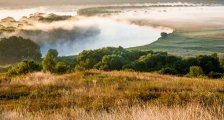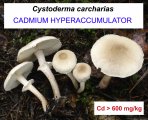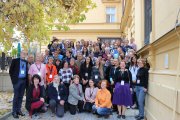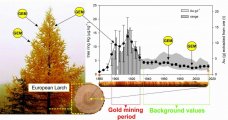News archive
News older than one year.
2018 Outstanding Student Poster Award for Šárka Křížová
Ing. Šárka Křížová of the Department of Analytical Methods was awarded the 2018 Outstanding Student Poster Award at the International European Planetary Science Congress (EPSC 2018) held in Berlin on September 16–21, 2018. The award honored her results in the study of Australasian tektites.
Opportunities for Soil Sustainability in Europe
During November 2016, the Dutch Academy offered to lead an EASAC project on soils and organized a workshop for 20 pedology experts. This report has been recently submitted to the European Union as an obligatory document for a debate on soil sustainability. The project benefited from the work of its authors and reviewers of the Institute of Geology CAS (L. Lisá as a co-author and A. Žigová as one of the reviewers). The complete report of EASAC is available here. The document is free to distribute. The principal aim of EASAC is to unify the National Academies of Sciences of EU, Norway and Switzerland to provide scientific expertise to EU politicians. For additional information see here.
Cadmium hyperaccumulation and its chemical form in Cystoderma carcharias
Macrofungi (mushrooms) may accumulate high concentrations of toxic metals in their fruit-bodies. The team led by Jan Borovička of the Department of Environmental Geology and Geochemistry (GLI) has focused on the saprotrophic fungus Cystoderma carcharias. According to the joint study published together with collaborating laboratories (University of Chemistry and Technology Prague, University of Graz, Nuclear Physics Institute CAS, Charles University), cadmium concentrations in C. carcharias are elevated at pristine sites. However, concentrations reaching 600 mg/kg in dry weight, the highest ever reported in macrofungi under natural conditions, have been found from a polluted site in the vicinity of Příbram (Central Bohemia, Czech Republic). In the study published in Science of the Total Environment (IF 4.610) the authors investigated the chemical species of the accumulated elements, particularly cadmium and arsenic. Cadmium appeared to be associated with specific proteins (possibly metallothioneins) but arsenic was present in numerous low-molecular-weight methylated compounds of which two have been known only from marine environments yet.
The seminar "Dust Particles"
The seminar "Dust Particles" was held in cooperation with the Institute of Geology of the Czech Academy of Sciences, v.v.i. and the Institute of Rock Structure and Mechanics of the Czech Academy of Sciences, v. v. i. on Monday, October 22, 2018. The seminar was devoted to the study of dust particles and aerosols and their impact on the environment and humans. It brought together scientists and the public interested in the topic. The whole event was supported by the AV21 Strategy under the Natural Threats Research Program.
19th Czech–Slovak–Polish Palaeontological Conference and the 11th MIKRO 2018 Worskshop
The Institute of Geology of the Czech Academy of Sciences organized the 19th Czech–Slovak–Polish Palaeontological Conference together with the 11th MIKRO 2018 Worskshop on 18th–20th October 2018. The conference took place in Villa Lanna, a beautiful architectonic place and a representative residence of the Czech Academy of Sciences. One-hundred and two researchers from the Czech Republic, Slovak Republic, Poland, Ukraine and Slovenia participated in the conference. There were representatives of a wide range of interests including palaeobotany, palaeozoology, micropalaeontology and also anthropology. Forty-four lectures and forty-seven posters were presented during this conference. The last day, a guided field excursion focused on stratigraphy and tectonics of the Prague Basin was led by František Vacek of the National Museum. A special issue of the Folia journal dedicated to this conference was published. It is available through the Library of the Institute of Geology or on the official webpage of the Folia journal.
Larch tree rings: an archive of atmospheric Hg pollution
Tree rings are known to reflect not only climatic changes but also to contain information on environmental pollution. The recent publication by members of The Department of Environmental Geology and Geochemistry in the GLI led by T. Navrátil accepted to the prestigious Environmental Science & Technology journal (IF 6.653) describes and discusses the changes of atmospheric Hg recorded in the European larch tree rings. The study was conducted at several sites in the Czech Republic. The tree ring records document, for example, atmospheric Hg variations in the vicinity of a gold ore amalgamation processing plant (Roudný site), near a Pb-ore smelter (Příbram site) and around a chlorine-alkali plant. Detailed information can be found in the just accepted paper.
Leadership of the GLU in Academic Magazines
Interview with director Dr. Tomáš Přikryl issued the AB academic bulletin. In this interview, Dr. Přikryl describes some of research topics of the staff and outlines the way of their work. For details (in Czech) click here.
In the second official academic magazine “Áčko- science and research”, an article was published based on an interview with the deputy director Dr. Michal Filippi. This article describes long-term research performed in a unique salt karts in Iran, but also a new exploration of the unknown karst regions in central China. For details (in Czech) click here.
Summer course of lithium geology
Lithium (Li) is one of the most popular raw materials for modern technologies. With the prospect of electricity management from renewable sources and the proposed development of electric mobility, the use of lithium batteries will increase substantially in the next decade. In Europe, the Bohemian Massif is a positive geological anomaly, containing the largest potential Li resources within the European Union. In order to support the theoretical knowledge of geological processes leading to lithium resources and to provide young scientists with information needed for lithium ore prospection and analysis, the Institute Geology of the Academy of Sciences of the Czech Republic organized the Course of Lithium Geology for graduate students. The course took place on August 27–September 1, 2018, in the Krušné Hory Mts. (Erzgebirge) with the participation of 13 students from 9 countries. Up-to-date scientific knowledge was provided to them by four leading specialists from the Institute of Geology, the Masaryk University and the Mendel University. The course also included an excursion to the former tin mines, now potential lithium sources, near Krupka and Cínovec. The course was funded by the Academy of Sciences with the help of geological companies TIMEX Zdice, s.r.o. and Geomet s.r.o. Brno.
Discovery of specific volcanogenic structures in basaltic rocks of the Faroe Islands
The Faroe Islands (Føroyar) are formed by several thick series of subaerially emplaced plateau basalts of Palaeogene age. During the systematic volcanological survey of the Faroe Islands conducted since 2014, actively participated by Assoc. Prof. RNDr. Lukáš Krmíček, Ph.D. of the Institute of Geology of the Czech Academy of Sciences, unusual volcanogenic structures occurring on the surface of a basaltic dyke located on the Sandfelli mountain ridge (754 m a.s.l.) were discovered. The rock wall of the dyke is covered by a dense mosaic of angular to rounded polygonal convex structures designated as pseudo-hieroglyphs. The discovery of pseudo-hieroglyphs, which probably represent unique examples of a chaotic stage of horizontal columnar jointing developed in basaltic rocks, has been described as a part of a worldwide natural heritage in the recent issue of the Geoheritage journal.
A new weathering form in sandstone
A recently published paper in Earth-Science Reviews (IF 7.051), which was also contributed by scientists of the Institute of Geology (Michal Filippi and Jiří Adamovič), presents a newly recognized weathering form termed arcades. The arcades develop on the surface of sandstones but also arkoses, granites and volcanosedimentary rocks as a consequence of “stress shadows” developed along planar discontinuities (i.e., bedding planes, joints, etc.). Using physical and numerical modelling, this paper evidences that it is a principal feature of weathering of granular rocks, which explains also the origin of other widely known geomorphic forms of various sizes – such as rock pillars, some rock shelters or ledges.











